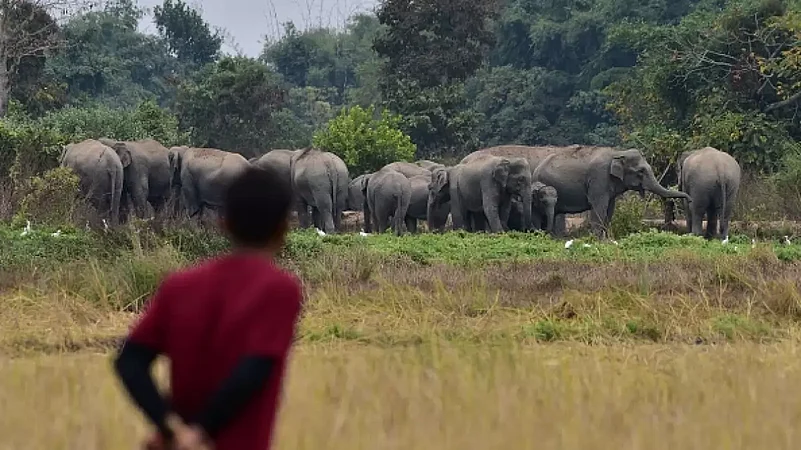Ganesh Kumar, 37, a resident of Bakarkudi village in Seraikela Kharsawan district, Jharkhand, stepped out of his house in the morning to answer nature’s call. He saw an elephant charging towards him. Even before he could react or do anything, the elephant attacked him, wrapped him in its trunk and tossed him on the ground. Kumar died on the spot.
The villages and blocks close to the Dalma Wildlife Sanctuary have witnessed a dozen elephant attacks recently. The sanctuary, around 10 kilometres from Jamshedpur, is home to a significant population of elephants. These elephants move freely in Tamar, Chandil Bundu and Silli areas—all close to the sanctuary—and enter villages. These casual visits sometimes take an ugly turn.
Many people and organisations have been involved in spreading awareness about the human-elephant conflict and teaching the villagers what to do in the case of an attack. One such initiative is the ‘Haathi Mitra Samuh’ that was launched a year ago. More than 2,000 people are associated with the initiative’s WhatsApp group. “We try to create awareness. Through our initiative, we try to save both, elephants, and humans. We rushed to the spot when we came to know Kumar was attacked. Unfortunately, he could not make it,” says Tapas Karmakar, who is a part of the initiative.
But why are such large numbers of elephants suddenly entering the villages? “This area is known as the elephant corridor, but ever since the Ranchi-Tata National Highway has come up, this stretch is no longer safe for elephants. It has been built on the path that elephants used to take earlier, which is why more elephants are wandering into villages, leading to increased cases of attacks and deaths,” says Karmakar.
As per the Jharkhand Forest Department, from the year 2000—when the state came into being—until March 31 this year, 1,664 people have lost their lives due to the human-elephant conflict. The number of injured people stands at 3,035. These figures prompt the question—who is responsible for these horrific deaths in the last 22 years?
Not just in Jharkhand, such conflicts have increased in Odisha, Chhattisgarh and West Bengal as well. According to the Union Ministry of Environment, Forests and Climate Change, between 2017 and 2022, 462 people died in Jharkhand; 385 in West Bengal and 358 in Assam. Between 2018-19 and 2022-23, 337 people lost their lives in Chhattisgarh.
The Dalma-Chandil corridor is used by elephants for movement in the forests of Saranda district, which is a dense forest having numerous Sal trees. Spread across 82,000 hectares, this forest covers areas of Odisha, as well as many districts of Jharkhand. However, also present in these forests are 2,000 million tonnes (MT) of precious iron ore.
In the 1990s, this area was considered to be elephant-friendly, however, incessant mining activities have proved to be detrimental to their existence. Jharkhand-based Rakesh Kumar Singh, director of Initiative to Protect Biodiversity and Environment, has, over the years, conducted extensive research on elephants in Saranda. He believes that the government’s policy failure is the root cause of the growing conflicts between humans and elephants.
“There are two major reasons—mining and linear development, like the building of highways and forest diversions. Companies undertaking mining projects in the forest area claim they won’t touch the elephant corridor. However, mining activities and linear development happen in the traditional habitat area, leading to their disoriented movement. This has enhanced the conflict,” he says. Because of mining activities, elephants have been forced to move away from their traditional habitats and migrate to new areas. “Once they enter the villages, there is retaliation in the form of killing of elephants and humans. They are chased from one place to the other,” he adds.
Due to illegal and incessant mining, many trees in Saranda have been cut down, leading to deforestation. According to a study conducted by the Wildlife Institute of India (WII) in 2015-2016, plant species in Saranda have declined from 300 to 87. In the last 15 years, due to development and mining activities,16,000 hectares of forest land have been used for non-forest purposes, says another report. In the last 40 years, 10,451 hectares of forest land—the largest in terms of density—has been allotted for mining. Most of it falls in the Keonjhar district of Odisha leading to human-elephant conflict in more than 500 villages. Moreover, in the last ten years, 1.85 crore trees have been cut for road construction in Odisha.
Deforestation in Jharkhand, Odisha and Chhattisgarh is making the forests less dense. As per the experts, to maintain the elephant population, a 200 sqkm of dense forest area having no human population is a must.
Biswajit Mohanty, a Cuttack-based environmentalist and the secretary of Odisha Wildlife Society, says the iron ore-rich districts of Angul, Devgarh, Kangra and Dhenkanal top the list when it comes to human-elephant conflict. The construction of a canal at Angul has divided the area, thereby trapping the elephants. “We have found in our study that in Dhenkanal district, encroachment has gone up ten times between 2011 and 2021.
Encroachment is leading to forest fragmentation. This forces the elephants to move away from their traditional habitat. People chase and throw stones at them. Out of anger, these elephants come back, attack and kill humans.
In February this year, in five districts of Jharkhand, including Ranchi, in a span of 12 days, a 12-year-old elephant had killed 16 people, which made headlines. After putting in a lot of effort, the forest department was successful in calming the elephant. A committee was tasked to find out the reason behind the frequent attacks. “This elephant got separated from its group. People started pelting stones at it and even threw fireballs. This angered the elephant. It finally managed to reach Itki, which has a lush green patch. The presence of three elephants there helped it calm down,” says Shrikant Verma, the DFO of Ranchi. However, the situation was so grave that Section 144 was imposed in the Itki block of Ranchi and people spent sleepless nights.
According to environmental wildlife expert Dr Daya Shankar Srivastava, due to the lack of natural food, a dangerous tendency is being developed in the new generation of elephants. They have now started eating grains in farms and homes, leaving their traditional food.
Srivastava says: “We need to understand why this is happening. Elephants have a very strong-smelling power. They need 700-1,400 kg of food that can be found only in the forests. They tend to move around but return to their original place once a year. The cycle continues. But now there are hindrances in terms of roads, mines and dams. So they forcibly enter the fields and eat crops.”
He feels these conflicts can be reduced if mining activities are controlled or stopped and afforestation is encouraged. People should be discouraged from pelting stones or fireballs at elephants or chasing them.
According to the forest department, 1.6 lakh cases have been registered. If we divide this, there are 2,705 cases of crop damage. During this period, crops of 490.810 hectares of land and 1913.390 quintal grains have been damaged.
The forest department too feels that deforestation has led to the disturbance of elephant habitat and this has increased the cases of conflict. Jharkhand-based Chief Conservator of Forest (wildlife), Sasikar Samanta, says: “Elephants have a fixed corridor. They use this once a year for their commute. Due to the increase in population, no area in the forest now is without human footprint. This has disturbed the elephant habitat. Trees are being cut. Their habitat is shrinking. Deforestation has left no food for elephants. Elephants are very innocent. When people constantly attack them, they retaliate.”
Many areas of Jharkhand are connected to the Purulia district of Bengal, Sundargarh and Mayurbhanj districts of Odisha, like Ranchi, East Singbhum, and Saraikela Kharsawan are close to Bengal while East Singbhum and West Singbhum to Odisha’s Sundargarh and Mayurbhanj districts. These areas come under the Saranda forest. Through the corridor, these elephants can easily commute from one state to the other. To date, 150 such corridors have been identified in India. A maximum of 26 such corridors are found in Bengal, 17 in Jharkhand and 14 in Odisha.
Murubala Soren, 72, a resident of Tikatand village in Bagmundi block of Purulia, while attending nature’s call on November 27, was held in the trunk of the elephant and killed. While talking Murubala, an activist of that area, Jayanta Mahato, says: “He could not hear properly. People had warned him against venturing out, as they had seen the elephant, but of no accord. In the morning, the family had asked him not to go out, yet he left. Even when the elephant was near, he did not hear its sound. Since he was old, he could not even run to save his life.”
Mahato says that when these elephants are chased by the Jharkhand Forest Department, they enter these areas, killing people in anger.
According to the information obtained through RTI by Uttarakhand-based activist Hemant Gonia, 1,381 elephants have died due to unnatural causes from 2009 to 2023. These include cases of deaths on account of electric currents as well as poison. According to the Jharkhand Forest Department, 80 elephants have died in Jharkhand between 2000 and 2020.
Sonal Tiwari, advocate, Jharkhand High Court, says: “Why elephant deaths are common in the time period when there are elephant movements in the protected areas or the corridors? Suo Moto cognizance of such matters must be taken whenever there are elephant deaths. The forest department must look into these matters very carefully and they must make sure that no such incident gets repeated in the area for the same reason.”
“There is no doubt that mining is one of the reasons. But the bigger reason is that wildlife strategic management plans have never been implemented in the state in words and actions. All the diversion of forests required management of wildlife but the departments never take these things seriously. In Jharkhand, a railway track is coming in the corridor area; the state government has objected to it, but the Ministry of Railway wants to complete the project without even understanding the movement of elephants and its larger impact.”
(Translated by Kaveri Mishra)



























